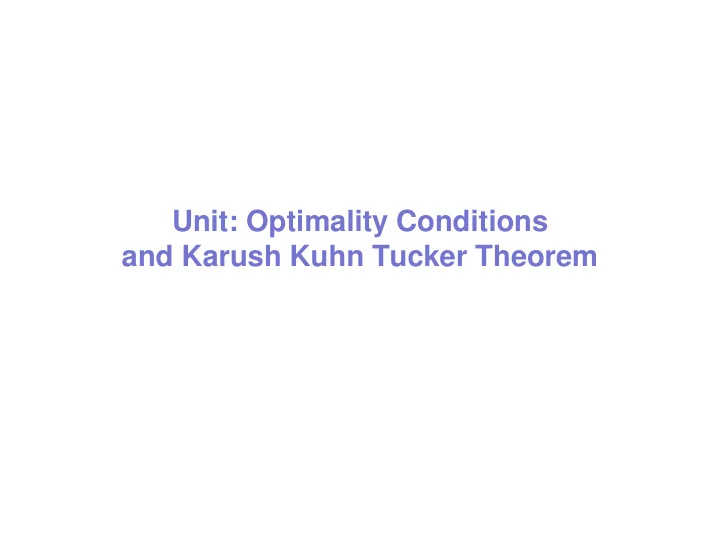

Unit: Optimality Conditions and Karush Kuhn Tucker Theorem
Goals 1. What is the Gradient of a function? What are its properties? 2. How can it be used to find a linear approximation of a nonlinear function? 3. Given a continuously differentiable function, which equations are fulfilled for local optima in the following cases? 1. Unconstrained 2. Equality Constraints 3. Inequality Constraints 4. How can this be used to find Pareto fronts analytically? 5. How to state conditions for locally efficient in multiobjective optimization?
Optimality conditions for differentiable problems • Given a point on a continuous differentiable function. A sufficient condition for a point � ∈ ℝ to be a local maximum is for instance f’(x)=0, f’’(x)<0 : �’(�) = 0, �’’(�) < 0 �(�) � • Necessary conditions, can be used to restrict the set of candidate solutions. ( f’(x)=0) • If sufficient conditions are met, this implies the solution is locally (Pareto) optimal, so it provides us with verified solutions. • A condition that is both necessary and sufficient provides us with exactly all solutions to the problem.
Recall: Derivatives
Recall: Partial Derivatives https://www.khanacademy.org/math/multivariable- calculus/partial_derivatives_topic/partial_derivatives/v/p artial-derivatives
Gradient / Linear Taylor Approximations
Example 1-Dimension
Gradient computation: Example Program: wxMaxima: load(draw); draw3d(explicit(20*exp(-x^2-y^2)-10,x,0,2,y,-3,3), contour_levels = 15, contour = both, surface_hide = true);
Gradient properties The plot shows the Gradient at different points of the function (Gradient field) f(x 1 ,x 2 )= 20 exp(-(x 1 ) 2 – (x 2 ) 2 ) Program: wxMaxima: f1(x1,x2):=20*exp(-x1^2-x2^2); gx1f1(x1,x2):=diff(f1(x1,x2),x1,1); gx2f1(x1,x2):=diff(f1(x1,x2),x2,1); load(dfdraw); drawdf([gx1f1(x1,x2),gx2f1(x1,x2)],[x1,-2,2],[x2,-2,2]);
Single objective, unconstrained
Single objective, unconstrained (example)
Constraints (equalities) Show that this yields m+n equations with m+n+1 unknowns.
Constraints (equalities) - interpretation Common tangent line
Example: One equality constraint, three dimensions Level curve of f: f(x1,x2,x3)=const All solutions that satisfy The equality constraints are located on the n the gray surface.
Example: 2 Equality constraints, three dimensions Points on the intersection of The two planes satisfy both constraints.
Constraints (inequalities) Albert William Tucker Harold W. Kuhn Canadian US-American Mathematician, Mathematician 1905-1995 1924-2014
Constraint (inequality)
Geometrical interpretation KKT conditions f g a2 g a1 x
Multiobjective Optimization [cf. Miettinnen ‘99]
Unconstrained Multiobjective Optimization In 2-dimensional spaces this criterion reduces to the observation, that either one of X* the objectives has a zero gradient ( neccesary condition for ideal points) or the gradients are parallel.
Strategy: Solve multiobjective optimization problems by level set continuation
22 Strategy: Find efficient points using determinant • ∃ �: ��� � � + ∇� � � = 0 Linearly dependent ⇒ • det [�� � , �� � ] = 0 • Efficient points can be found by searching for points with � → ��� det �� � , �� � (necessary condition) • Single objective optimization, multiple minima Multiobjective Optimization, Autumn 2005: Michael Emmerich 22
Take home messages 1. Gradient is a vector of first order partial derivatives that is perpendicular to level curves; Hessian contains second order partial derivatives. 2. Local linearization yields optimality condition; in single objective case ‘gradient zero’ and positive/negative definite Hessian. 3. Lagrange multiplier rule can be used to solve constrained optimization problems with equality constraints. 4. KKT conditions generalize it to inequality constraints; negative gradient points in cone spanned by active constraints. 5. KKT conditions for multiobjective optimization require for interior points to be optimal that they have gradients which point in exactly the opposite directions. 6. KKT conditions define equation system the solution of which is an at most m-1 dimensional manifold
References • Kuhn, Harold W., and Albert W. Tucker. "Nonlinear programming." Proceedings of the second Berkeley symposium on mathematical statistics and probability . Vol. 5. 1951. • Miettinen, Kaisa. Nonlinear multiobjective optimization . Vol. 12. Springer, 1999. • Miettinen, Kaisa. "Some methods for nonlinear multi-objective optimization." Evolutionary Multi-Criterion Optimization . Springer Berlin Heidelberg, 2001. • Hillermeier, C. (2001). Generalized homotopy approach to multiobjective optimization. Journal of Optimization Theory and Applications , 110 (3), 557-583. • Schütze, O., Coello Coello, C. A., Mostaghim, S., Talbi, E. G., & Dellnitz, M. (2008). Hybridizing evolutionary strategies with continuation methods for solving multi-objective problems. Engineering Optimization , 40 (5), 383-402.
Recommend
More recommend